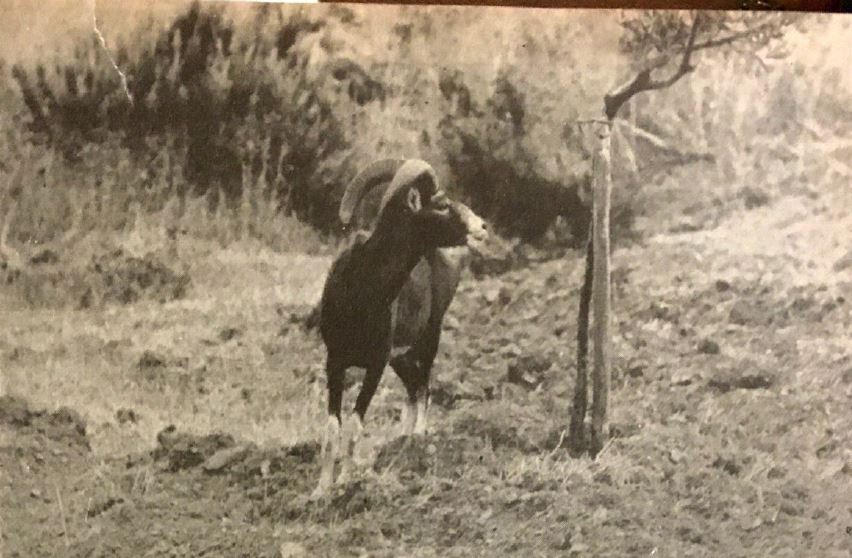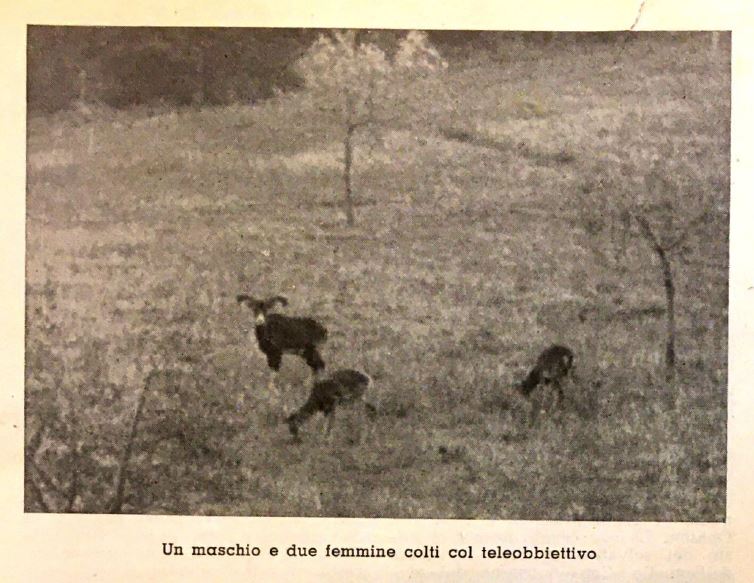Historical Documents, Studies & Articles
Follow the links to read the published resources.
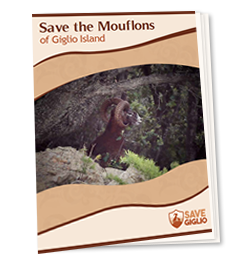
Save the Mouflons of Giglio Island Presentation - August 26, 2022
Click here to download the report in PDF format complete with bibliography.
DOWNLOAD PDFHistorical Documents

Excerpt from the Mouflon Conservation Project in the 1950s at Giglio
The project for the defense of the mouflon (ovis musimon) was agreed upon and developed with the late Prof. A. Ghigi, A. Toschi and R. Videssot. These three great champions of the protection of Nature during their lives, always aiming at this very noble goal, showed how one can and must love one's country in times of peace not only by defending the...
Read More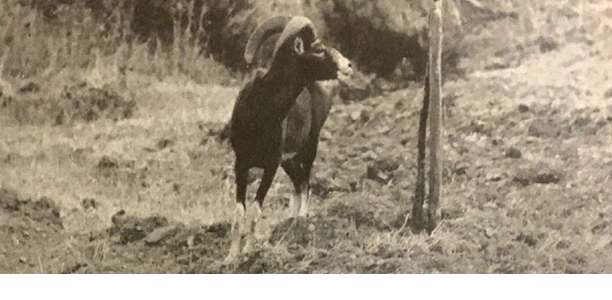
Excerpt from Diana Magazine of January 31, 1959
On Giglio this achievement has been reached in an area west of the island called "The Franco", located between Poggio Zufolone and Poggio Giannetto, above Campese, with the creation of the "Parchetto del Franco", an extension of almost 100 hectares completely fenced, an oasis desired and cared for by Professor Baldacci who loves nature and hunting with such dedication that he considers them as his indispensable element of life.
Read MoreDatabase Information
CABI - Compendium of Invasive Species
Mouflon Description. "...no adverse effects on the native environment have been found in many countries (thus it is not to be considered invasive)" This datasheet presents 140 references.
https://www.cabi.org/isc/datasheet/71353IUCN Database - Invasive Species Specialist Group
This website identifies the Mouflon as an "invasive" species based on studies on the Channel Island and Hawaii, where herbivores have harmed endangered plant species in these places. Note: The mouflon has never been present in the Channel Islands and the data collection is for large herbivores.
http://www.iucngisd.org/List of alien and invasive species of European Union Concern
"The Regulatory Core (EU) 1143/2014 provides the list of allochthonous and invasive species concerning the European Union (the E.U. list)" The mouflon is not on the list.
https://ec.europa.eu/EASIN - European Union Alien Species Information Network
This is the E.U. list that contains 14,000 allochthonous species. Type in "Ovis Aries" in the search field ("Search Name"). Mouflons are identified as ‘high impact’ based on CABI, however CABI does not consider the species invasive.
https://easin.jrc.ec.europa.eu/The Mouflons of Giglio: Expert Opinions

Dr. Alessio Zanon, Veterinary Physician Expert in Zootechnical Biodiversity
"Giglio still represents a reservoir of genetic diversity that is too important to be sacrificed in the face of alleged inadequately supported and studied damage."
Read More
Prof. Franco Tassi, Head of the National Parks Committee
"There are certainly valid and effective alternatives to the absurd methods with which the Tuscan Archipelago National Park, even with European LIFE funds, strives to bring Death to the Small Islands, and in particular to Montecristo and Giglio: one can and must instead safeguard Life, and if necessary, one could also relocate Life elsewhere."
Read More
Dr. Franco Perco, Former Director of Monti Sibillini National Park
"I think this is an important opportunity for a National Park and beyond,not to be wasted but instead to be enhanced with real outdoor ethology schools."
Read More
Prof. Marco Masseti, Zoologist, Paleo-Ecologist & Insular Fauna Expert
"From Sammuri's statements it seems to be understood that he does not consider Giglio, let alone the islanders, worthy of being listened to. In fact, he doesn't need dedicated scientific studies, nor has he wasted time asking and listening to the opinion of the population and locals before making such important and definitive decisions."
Read More
Dr. Barbara Wilkens, Archaeozoologist
“Mouflons have given rise to all present-day sheep and have accompanied our civilization from the ancient Neolithic to the present, that is, for about 8,000 years in our territories and even longer in their Near Eastern homelands. What is meant by an alien species? How long must pass after its arrival for a species to no longer be considered alien? If it has settled well into the environment, is 8,000 years enough time?”
Read MoreConservation Projects for Mouflons
KORA/MALME Metapopulation Approach for Large Mammals in Europe Case Study Alps Risk of loss of genetics
"in the high marginal areas and in the foothills, where chamois is not present, the idea of introducing Mouflon, to increase Biodiversity... is not to be excluded [Tosi and Lovari 1997]."
Download PDFExcerpt from the Mouflon Conservation Project in the 1950s at Giglio
The project for the defense of the mouflon (ovis musimon) was agreed upon and developed with the late Prof. A. Ghigi, A. Toschi and R. Videssot. These three great champions of the protection of Nature during their life...
Read MorePreservation of the Wild European Mouflon: The First Example of Genetic Management Using a Complete Program of Reproductive Biotechnologies- March 2002
Here we describe for the first time the rescue of an endangered species, the European mouflon (Ovis orientalis musimon), by the application of an integrated package of reproductive biotechnologies. One species classified as vulnerable (i.e., facing a high risk of extinction in the wild in the medium-term future) is the autochthonous population of European mouflon, which inhabit only the islands of Sardinia and Corsica. In Sardinia, the expansion of sheep farming has eroded the available habitat of the European mouflon, resulting in a reduction in their numbers and their dispersal into small, isolated groups. Such developments threaten the survival of the European mouflon as a population’s probability of extinction is directly correlated with its variability and inversely correlated with density and immigration rate.
https://academic.oup.com/Cloning the Wild Mouflon, written by Tracy Heatherington - February 2008
Reference to the importance of genetic resource conservation. Discussion of genetic essentialism and continuous improvement of conservation techniques for biological endemics.
Download PDFA LIFE Project 2003-2007: Conservation and diffusion of Corsican Mouflon populations in Corsica
The Project aims at the protection and conservation of the entire population of the Corsican Mouflon (Ovis gemelini musinom var.corsicana). Considering the numerous attempts and the long time needed to carry out a program to defend wild ungulates through captive breeding, this LIFE Project will mainly contribute to launch the program in the next 5 years.
Download PDFUpdate of the Wildlife Vocation Map of Sardinia: Ungulates Section. Sassari, Sardinia, Italy: University of Sassari -2012
The mouflon is a historically autochthonous animal species in Sardinia. The same data elaboration gives an estimate of mouflon density for this survey area of about 11 heads per 100 hectares."
http://www.sardegnaambiente.it/Giglio mouflon have not been proven to pose a threat to habitat
On Giglio Island, no independent local study has shown that mouflons have harmed the island's biodiversity. The following documentation strongly suggests that mouflons have a behavior and diet that does not allow the species to become invasive or threatening to habitat in the Mediterranean context.
STERNA 2006 with the scientific supervision of INFS now ISPRA and Silvano Toso, former director of INFS now ISPRA, states, "The mouflon is one of the least demanding wild ungulates about food quality and at the same time very attached to the herbaceous component of the vegetation during the summer period while in the autumn period there is a progressive increase in the use of semi-woody dicotyledons and their leaves....."
from the Quaderni de Georgofili, Department of Plant Biology University of Florence 2009, reads, "It is characteristic of mouflons to establish a kind of balance with food resources. In fact, damage is always very low and evenly distributed as if they tend to minimize disturbance by distributing it as much as possible over the territory."
further: "The predilection of mouflons for woody vegetation makes them tools of incalculable value for the conservation of scrublands and forests."
again, "On the islands of the Archipelago, Hot Spots of damage have been shown to be low for mouflon in all study areas." - Same goes for animal biodiversity:
STERNA 2006: "There is practically no food competition between mouflon and cervids while negative interactions are reported only with chamois," which is not present in the Tuscan Archipelago.
The problem of the invasiveness of a species is logically linked to the place and the density of the population and that it makes no sense to generalize referring among other things to situations very distant from ours (there are no specific studies conducted at Giglio, only generalizations based on research afferent to exotic islands such as Hawaii). The density of Mouflons at Giglio is about 1-2 Mouflons per 100 hectares, and it is far from being a danger to biodiversity (which can occur with densities higher than 28 - 30 Mouflons per 100 hectares, in a Mediterranean island context).
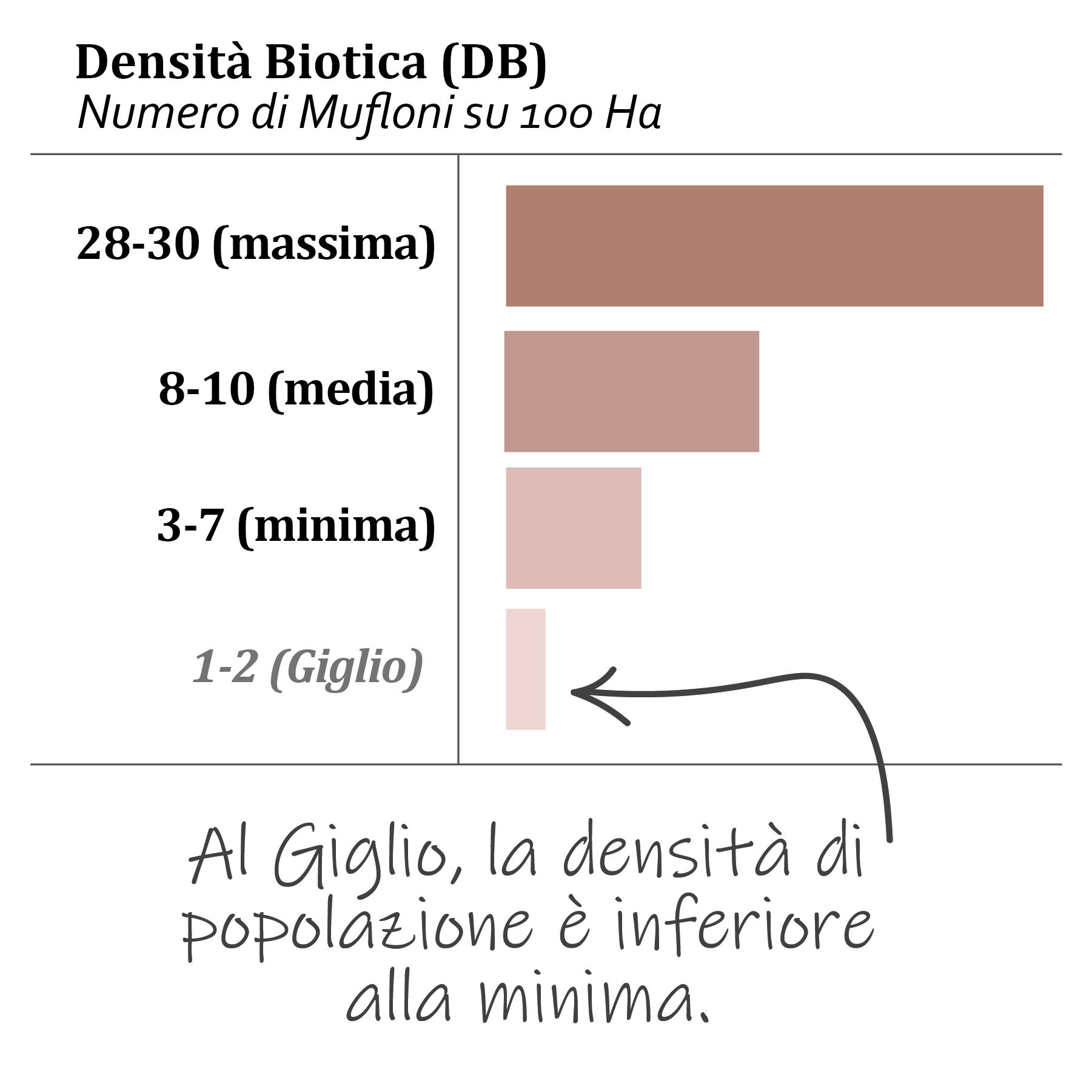
Legislazione
REGOLAMENTO (UE) N. 1143/2014 DEL PARLAMENTO EUROPEO E DEL CONSIGLIO del 22 ottobre 2014 - recante disposizioni volte a prevenire e gestire l’introduzione e la diffusione delle specie esotiche invasive
(1) La comparsa di specie esotiche, che siano animali, vegetali, funghi o microrganismi, in nuovi luoghi non è sempre fonte di preoccupazione. (25) È opportuno prendere in considerazione metodi non letali e tutte le azioni adottate dovrebbero ridurre al minimo l'impatto sulle specie non destinatarie di misure.
Scarica il PDFPoint (1) of its introduction states, "The appearance of exotic species, whether animals, plants, fungi, or microorganisms, in new locations is not always a cause for concern. However, exotic species, if they reach a considerable number, can become invasive...." at Giglio, mouflons are not a considerable number.
Furthermore, item (25) reads, "It is appropriate to consider non-lethal methods..." killing is lethal.
Again, item (29) states, "Directive 2003/35/EC of the Parliament and of the Council established a framework for public consultation in decisions relating to the environment. When defining how to take action on invasive alien species, effective public participation should, on the one hand, allow views and concerns to be expressed that can usefully influence decisions and, on the other hand, enable decision-makers to take those views into account..." confrontation that has not happened indeed, the islanders, with the collection of thousands of signatures, want the mouflons to remain on the island.
Article 2 defines invasive exotic species as: "an exotic species whose introduction or spread has been found to threaten or adversely affect biodiversity and related ecosystem services."
Article 3 defines eradication as: "the complete and permanent elimination of the population of an invasive alien species by lethal or nonlethal means."
Article 12.1 states, "Each member state may establish a national list of invasive alien species of national importance..."
In Art. 26 it stipulates public participation in developing action plans. Which has not been done.
WHEREAS, the mouflon is NOT among the invasive alien species of EU relevance listed in the EU Implementing Regulation 2016/1141 of the Commission of July 13, 2016, and the Decree of January 19, 2015 of the Ministry of the Environment states in the preamble and Article 1 that "those animal or plant species are to be considered parautochthonous which, although not native to Italian territory, have arrived there by direct intentional or unintentional human intervention and therefore naturalized in an ancient historical period prior to 1500 AD )..." In the list, Ovis aries gmelini (i.e., Ovis orientalis musimon) is listed among the parautoctonous mammals, Sardinia being the area of parautoctony.
LAW FEB. 11, 1992, NO. 157, ART. 18, COMMA 1
c) species huntable from Oct. 1 to Nov. 30: ptarmigan (Lagopus mutus); black grouse (Tetrao tetrix); black grouse (Bonasa bonasia); rock partridge (Alectoris graeca); alpine chamois (Rupicapra rupicapra); roe deer (Capreolus capreolus); deer (Cervus elaphus); fallow deer (Dama dama); mouflon (Ovis musimon), excluding the Sardinian population; white hare (Lepus timidus);
From Action A.1 - Deliverable “Operational protocol for the eradication of Mouflon (Ovis aries) at Giglio Islan” PROGETTO LETSGO GIGLIO Less alien species in the Tuscan Archipelago: new actions to protect Giglio island habitats LIFE18 NAT/IT/000828 April 2021
Download PDFPage 4- "The latest molecular studies suggest that the European mouflon derives from a phase of at least partial domestication supporting its inclusion in the species Ovis aries (Hiendleder et al., 2002; Sanna et al., 2015). Currently, Sardinian populations are still believed to retain a significant portion of the original genetic diversity currently lost or depleted in wild Asian relatives, and this factor suggests that they should be targeted for conservation unlike others found in the country (Loy A., et al., 2019)."
Page 28- "Pursuant to Law No. 157, Article 18, Paragraph 1 of February 11, 1992, the Mouflon, excluding the Sardinian population, is a huntable species in our country."
Articles About the LIFE Project on the Island of Elba
Empty Cages - FOR THE MUFLONS OF ELBA ISLAND - May 2017
Letter sent to the Ministry of the Environment, the Region of Tuscany, the Prefecture of Livorno, the municipalities of the Island of Elba and various newspapers
https://gabbievuote.it/Eradication of Mouflons on Elba, Sammuri Responds to Volpi of WWF
Sammuri: "With that said, it would not be necessary to verify the negative impact of an alien expenditure on a case-by-case basis in order to attempt its eradication, especially on an island... As said at the beginning an alien species is introduced voluntarily or involuntarily by humans and it is always a mistake."
https://www.greenreport.it/Evaluations of ISPRA on the Mouflon Control Plan – Island of Elba
"In the last few weeks, ISPRA has received numerous notes and alternative proposals from Tuscan animal welfare associations regarding the Muflone control interventions underway on the island of Elba, Tuscan Archipelago National Park. With this note ISPRA therefore intends to provide some clarifications in particular on the technical-scientific criteria adopted by ISPRA for the drawing up of the opinions issued upon request of the Park Authority".
https://www.isprambiente.gov.it/Found: The Protected Oasis that will Save the Mouflons of Elba from Extermination
After two years of work, only 13 mouflons (of 500) have been accepted by the Centro Recupero Animali Selvatici della Maremma. The Park Authority ordered the segregation of females and males within the reserve.
https://www.toscanachiantiambiente.it/Park Authority Sites
Stay With LIFE
https://www.restoconlife.eu/en/LIFE - LetsGo Giglio
https://www.lifegogiglio.eu/en/LIFE - LetsGo Giglio - Public Notice of Training Course of the Tuscan Archipelago National Park for Volunteers to Participate in Mass Culling of Mouflons on Giglio
Scarica PDFFacebook Page of the Park Authority
https://www.facebook.com/Excerpt from the 1950s Mouflon Conservation Project at Giglio
Excerpt from the booklet "Prof. Ugo Baldacci, Discipline of Hunting and General Interest, "La Riserva di Caccia" n. 3/1975"
“The project for the defense of the mouflon (ovis musimon) was agreed upon and developed with the late Prof. A. Ghigi, A. Toschi and R. Videssot. During their lives, these three great champions of the protection of Nature, always aiming at this very noble goal, showed how one can and must love one's country in times of peace, not only by defending the little that remains to be preserved for future generations, but above all by repairing the damage caused to the natural environment by a multi-millennial anthropic action always aimed at satisfying, day by day, the needs for meat, cereals, fuel and the practice of hunting, in the distant past used to defend oneself and feed oneself, in recent times for pure sporting pleasure”.

Photo Credit: Piero Landini
The breeding of the mouflon, a species protected by law because it is threatened by extinction, was started in 1955 in a closed fund, on the land of a hunting reserve, on the Island of Giglio (Grosseto).
These wild animals adapted well to the environment which was very similar to that of the island of origin, and every year the females, even those born in spring, gave birth to one or two young.
In 1962 the mouflons were by now in supernumerary in the closed fund of the Giglio; permission was requested to the Laboratory of Applied Zoology of Hunting as well as that of the Ministry of Agriculture and Forests to transfer a part of them in the Reserve of Miemo (Pisa) where they found abundant pasture, good ridges and calm.
The closed fund of Giglio and the Miemo Reserve have validly contributed to the protection of the mouflon and to its diffusion in Italy, which in '56 had the lowest population, among the other European nations, of this magnificent natural, wild animal of Sardinia and Corsica. From Miemo, in fact, mouflons have been sent to populate some Reserves in Tuscany, Lazio, Trentino, Friuli Venezia Giulia and Parks in Basilicata, Puglie and Veneto.
Excerpt from Diana Magazine of January 31, 1959
(...) if on the sloping crags of granite and gabbro one could see the imposing silhouettes of those beautiful wild animals of ours that are the mouflons, animals that around 1900 had already been introduced to the nearby island of Montecristo, and by now long since destroyed.
On Giglio this realization has been reached in an area west of the island called "Il Franco", situated between Poggio Zufolone and Poggio Giannetto, above Campese, with the creation of the "Parchetto del Franco", an extension of almost 100 hectares completely fenced in, an oasis desired and cared for by Professor Baldacci who loves Nature and hunting with such dedication that he considers them as his indispensable elements of life. The total fencing of this park, extended also on the side of the sea, has been carried out without economy of means, with galvanized net more than two meters high, overhung by barbed wires, and supported by thick posts, partly in wood and partly in iron, where necessary walled in the rock; the net is buried for about thirty centimeters.
This onerous fence not only protects the borders, but also prevents the sheep of some flocks from coming into contact with the mouflons who, as is well known, mate with them with a certain ease, which would compromise the current purity of their race.
In the morning we gather information from the guard and set off in search of the wild animals. My particular intention was to observe them in their environment, to photograph them and to take note of the order of the park.
In this park, with its thousands of paths through the high scrub, clean and tidy as in a garden, all the most favorable conditions and details for the development of game have been implemented: thus, among many works, the water has been wisely distributed in the various troughs located in the thickest of the scrub; in the meadow shelves, green pastures of suitable grasses. I also observe new species of plants that have been planted and are now thriving.
Giglio's mild climate also offers possibilities for citrus culture in the open ground, without shelter. A good reforestation on this island would be just as important as the introduction of game. I have noticed that even in the cracks in the rock where little earth emerges, there are robust shrubs and plants. In fact, at the beginning of the fifth century, Rutilio Numanziano wrote: Igilii silvosa cacumina minor; and again in 1594 a private individual contracted 11,000 stacks of holm oak wood for four years (Medicean Archives). The forest of tall trees would not take long to form again if man, as unfortunately happens, did not come in with an axe as soon as possible.
In the Parchetto del Franco, the scrub of alaterno, lentisk, arboreal heather, cistus, oak, Juniperus phoenica, which here, as in the Maremma, is called sabina, and many other plants dominate so that at Giglio there are about 780 species. In this area, in the process of being constituted as a closed reserve - supported by the authoritative praise of the illustrious Prof. Ghigi of the Zoology Laboratory - seven mouflons were released, four females and three males, of which a young male with the classic "saddle" still underdeveloped, and two females coming from Germany, from a Sardinian-Corsican strain, imported for the first time in Hungary around 1800 and fortified, while maintaining the purity of the breed, in Germany. The other subjects come from the reserves of Sardinia.
We come out of a grove of Aleppo pines and in a cultivated meadow bounded by a large spur of greenish rock (serpentine schist) on which rests a thick tangle of dog roses, we see a male Mouflon intent on a strange job. Mindful, perhaps, of the times in which the male shone for his chivalry, we see him start off with his head down and violently clash against the trunk of a young olive tree; at this shock some fruit falls from the plant and here are two females cautiously appearing from the bush, they come forward, eat the olives and perhaps thank him in their own way. But they still wait, they are certainly not full. And in fact the beautiful head of the mouflon stretches out towards the olive tree until it reaches a branch with its mouth, bites it and bends it towards the ground so that his companions can continue eating with more ease.
In the meantime, however, we had gotten too close and at the imperious alarm whistle of the male, the mouflons disappeared very quickly to reappear almost immediately, high up, glued to a cliff, from which they watched us curiously. They are beautiful!
This ovid would certainly deserve an even larger increase, as has already been done in America for one of its not-so-distant relatives, the Bighorn (Ovis canadensis). The Mouflon, or Capra Aegoceras of the ancients, seems to have also populated the Balearic Islands and the mountains of Greece. The Romans held it in high esteem for its delicious meat, and Pliny made a clear distinction between the mouflons of Corsica and those of Sardinia, calling the former Musmon and the latter Ophion. We resume our march and we enter the paths where on the sides the low scrub and the rock alternate more frequently. Here we see a brigade of beautiful and agile oriental partridges or Chukar; they pass in pairs in the uncovered stretches, following quickly. Others we can photograph with the telephoto lens in their peaceful environment. This game has magnificently reproduced itself, so that some brigades have even radiated on open ground. In order to protect this species, it would be desirable that the hunting authorities under whose jurisdiction this island is located, prohibit hunting absolutely for a certain period of time.
These birds are relatively domesticated and I think that this is due to the quiet life led in the Park, as it happens, after all, when the wild animals feel safe and quiet; (...). The chukar also lives well in proximity to the red partridge, so the latter will be released in the Parchetto del Franco this year.
(...) Of small snakes there is only the harmless whip snake, destroyer, mainly, of small mice. At the villa I have the occasion to taste a special grape jam, typical of the place, made almost without sugar and with a particularly pleasant taste.
Evening approaches. The Mediterranean scrub is dressed in a pale, evanescent pink and the dull rays of light filter through the winter mist making the black tip of the Pagana stand out. Alaterni, prickly broom and rosemary stand out in the humid breeze; from the low fishermen's huts, amidst the bluish smoke, gusts of "monachine" rise in the air that the wind carries along with the grateful smell of burning mastic.
We spend time after dinner playing cards next to the fireplace where large logs are burning; from the window we can see the white-green glow of the lighthouse beyond the Campese Tower. Outside, calm and silence; only the monotonous tapping of the rain gently cradles such peace...
On the return voyage, at the first light of dawn, sitting at the stern of the Aegilium which is now close to Porto Santo Stefano, I squint my eyes and see the outline of this island again, as if it were the shaggy rump of a sea monster resting on the water.
Up there, behind the Pagana, the chukar and the honey-eyed mouflon have come back to life, and look serenely at the blue expanse of the sea.
Valerio Masserini

